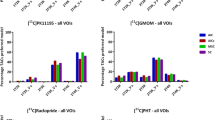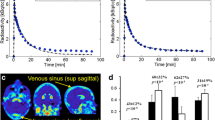Abstract
Quantitation of metabolic processes with dynamic positron emission tomography (PET) and tracer kinetic modelling relies on the time course of authentic ligand in plasma, i.e. the input curve. The determination of the latter often requires the measurement of labelled metabolites, a laborious procedure. In this study we examined the possibility of mathematical metabolite correction, which might obviate the need for actual metabolite measurements. Mathematical metabolite correction was implemented by estimating the input curve together with kinetic tissue parameters. The general feasibility of the approach was evaluated in a Monte Carlo simulation using a two tissue compartment model. The method was then applied to a series of five human carbon-11 iomazenil PET studies. The measured cerebral tissue time-activity curves were fitted with a single tissue compartment model. For mathematical metabolite correction the input curve following the peak was approximated by a sum of three decaying exponentials, the amplitudes and characteristic half-times of which were then estimated by the fitting routine. In the simulation study the parameters used to generate synthetic tissue time-activity curves (K 1-k 4) were refitted with reasonable identifiability when using mathematical metabolite correction. Absolute quantitation of distribution volumes was found to be possible provided that the metabolite and the kinetic models are adequate. If the kinetic model is oversimplified, the linearity of the correlation between true and estimated distribution volumes is still maintained, although the linear regression becomes dependent on the input curve. These simulation results were confirmed when applying mathematical metabolite correction to the [11C]iomazenil study. Estimates of the distribution volume calculated with a measured input curve were linearly related to the estimates calculated using mathematical metabolite correction with correlation coefficients >0.990. However, the slope of the regression line displayed considerable variability among the subjects (0.33–0.95), demonstrating that absolute quantitation of the distribution volume was impaired. Mathematical metabolite correction is a feasible method and may prove useful in cases where actual metabolite data cannot be obtained. The potential for absolute quantitation seems limited, but the method allows the quantitative assessment of regional ratios of receptor measures.
Similar content being viewed by others
References
Eriksson L, Kanno I. Blood sampling devices and measurements.Med Prog Technol 1991; 17: 249–257.
Westera G, Buck A. Burger C, Leenders KL, von Schulthess GK, Schubiger A.11C and123I labeled iomazenil: a direct PET-SPET comparison.Eur J Nucl Med 1996; 23: 5–12.
Buck A, Wolpers HG, Hutchins GD, et al. Effect of carbon-11-acetate recirculation on estimates of myocardial oxygen consumption by PET.J Nucl Med 1991; 32: 1950–1957.
Raylman RR, Hutchins GD, Beanlands RS, Schwaiger M. Modeling of carbon-11-acetate kinetics by simultaneously fitting data from multiple ROIs coupled by common parameters.J Nucl Med 1994; 35: 1286–1291.
Huesman RH, Coxson PG. Consolidation of common parameters in dynamic PET data analysis. In:IEEE Conference Record Nuclear Science Symposium and Medical Imaging Conference. 1990.
Chen KW, Huang SC, Yu DC. The effects of measurement errors in the plasma radioactivity curve on parameter estimation in positron emission tomography.Phys Med Biol 1991; 36: 1183–1200.
Feng D, Wang X. A computer simulation study on the effects of input function measurement noise in tracer kinetic modeling with positron emission tomography (PET). Comput Biol Med 1993; 23: 57–68.
Feng D, Huang SC, Wang X. Models for computer simulation studies of input functions for tracer kinetic modeling with positron emission tomography.Int J Biomed Comput 1993; 32: 95–110.
Koeppe RA, Holthoff VA, Frey KA, Kilbourn MR, Kuhl DE. Compartmental analysis of [11C]flumazenil kinetics for the estimation of ligand transport rate and receptor distribution using positron emission tomography.J Cereb Blood Flow Metab 1991; 11: 735–744.
Koeppe RA, Frey KA, Mulholland GK, et al. [11C]tropynal benzilate-binding to muscarinic cholinergic receptors: methodology and kinetic modeling alternatives.J Cereb Blood Flow Metab 1994; 14: 85–99.
Laruelle M, Baldwin RM, Rattner Z, et al. SPELT quantification of [123I]iomazenil binding to benzodiazepine receptors in nonhuman primates: I. Kinetic modeling of single bolus experiments.J Cereb Blood Flow Metab 1994; 14: 439–452.
Buck A, Westera G, von Schulthess GK, Burger C. Modeling alternatives for cerebral carbon-11-iomazenil kinetics.J Nucl Med 1996; (in press).
Flannery BP, Press WH, Teukolsky SA, Vetterling WT.Numerical recipes in C, 2 edn. Cambridge: Cambridge University Press, 1992.
Godfrey KR, DiStefano JJ. Identifiability of model parameters. In: Walter E, ed.Identifiability of parametric models. Oxford: Pergamon Press; 1987: 1–20.
Carson RE. Parameter estimation in positron emission tomography and autoradiography. In: Phelps M, Mazziotta J, Schelbert H, eds.Positron emission tomography and autoradiography: principles and applications for the brain and the heart. New York: Raven Press, 1986.
Delforge J, Syrota A, Mazoyer BM. Experimental design optimisation: theory and application to estimation of receptor model parameters using dynamic positron emission tomography.Phys Med Biol 1989; 34: 419–435.
Huang SC, Phelps ME. Principles of tracer kinetic modeling in positron emission tomography and autoradiography. In: Phelps M, Mazziotta J, Schelbert H, eds.Positron emission tomography and autoradiography: principles and applications for the brain and the heart. New York: Raven Press, 1986.
Westera G, Eberle I, Hunkeler W, Ametamey S, Schubiger PA. The production of [11C]iomazenil.J Labeled Compd Radiopharm 1993; 32: 169–170.
Author information
Authors and Affiliations
Rights and permissions
About this article
Cite this article
Burger, C., Buck, A. Tracer kinetic modelling of receptor data with mathematical metabolite correction. Eur J Nucl Med 23, 539–545 (1996). https://doi.org/10.1007/BF00833389
Received:
Revised:
Issue Date:
DOI: https://doi.org/10.1007/BF00833389




